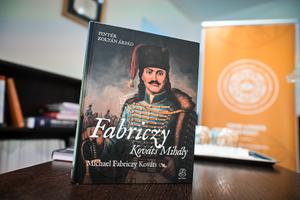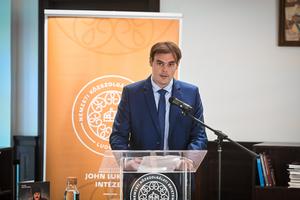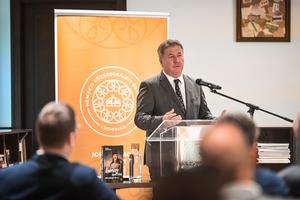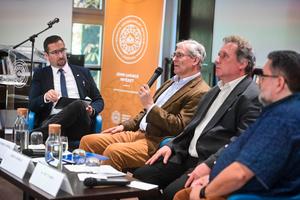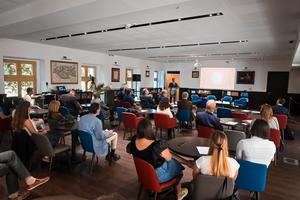The key achievements of Hungarians in the United States were the topic of the panel discussions organized by the John Lukacs Institute under the Michael Kovats Fabriczy Tricentennial on September 23rd at the Ludovika University of Public Service. The event “Hungarians in the United States of America” included renown experts who talked about the people and milestones that have enhanced Hungarian-American cultural bridges in the last three centuries.
The John Lukacs Lounge is an appropriate venue for highlighting the achievements of Hungarian Americans – noted Gergely Prőhle, Director of Programs at the John Lukacs Institute, who also emphasized in his opening remarks that in accordance with the spirit of the famous Hungarian American historian, we should not only dwell on the past, and that the memory of Michael Kovats Fabriczy gives us great strength for the future as well. Gergely Prőhle reminded that the important task of the Hungarian state is to preserve the Hungarian national memorial sites, in which a rear-guard action is taking place.
Zoltán Pintér, President of the Michael Kovats Fabriczy Friends Association noted that the co-founders of the American regular light cavalry were Michael Kovats Fabriczy Kováts and Kazimierz Pułaski, but in contrast to the Polish count, the Hungarian hussar colonel was rather forgotten by posterity. The Michael Kovats Fabriczy Friends Association and its partners – the Washington-based Kossuth Foundation and the Hungary Foundation – strive to place the most international Hungarian hussar on the worthy shelf of the historical pantheon. Zoltán Pintér added that a series of world-famous works and career paths prove that the seed of Hungarian talent has found fertile ground in the United States.
The first panel discussion highlighted memorable Hungarian achievements from American history. Dr. Tamás Magyarics, professor emeritus of Eötvös Loránd University, revealed Ágoston Haraszthy’s role in Californian wine culture, highlighting the adventurous life path of the Hungarian travel writer and vintner. Róbert Barta, Director of the Institute of History at the University of Debrecen, presented the work of John Lukacs, recalling that the historian with the triple identity predicted how multi-party democracies can turn into populist systems under the influence of the mass media. Tibor Glant, associate professor at the University of Debrecen, described the life of jazz guitarist Gábor Szabó: the musician, who emigrated in 1956, not only worked with famous icons of American jazz, but also re-visited Hungary several times from the 1970s, where he played jazz which had been banned before 1956 and later was only tolerated by the communist regime and Szabó presumably played an important role in this change.
In addition to the history of prominent Hungarians, the event also provided insight into the life of Hungarian Americans. Dr. Dániel Gazsó, research fellow at the Ludovika University of Public Service, briefly described the process of the institutionalization of the overseas Hungarian diaspora, recalling that after the 1960s the practice of so-called “diasporic responsibility” appeared, which in the case of overseas Hungarian communities was aimed at helping Hungarians living in the Carpathian Basin as a minority. This process has helped to strengthen the network of diaspora communities. On the other hand, following the major waves of political emigration – the arrival of the ’45-ers, the ’47-ers and the ’56-ers – in lack of replacement, it became increasingly important to involve younger generations, already born abroad, into community life. The formulation of objectives in this respect has significantly changed the way diaspora organizations operate and relate to each other.
Accordingly, the second panel discussion focused on Hungarians living in the United States today. Andrea Lauer Rice, President of the Hungarian American Coalition and the Hungarian Diaspora Council, reviewed the initiatives aimed at preserving the cultural values of Hungarian Americans. The founder of the annual Atlanta Hungarian Festival also presented the scholarship programs of the Hungarian American Coalition, and recalled the organization's role in the Hungarian American community-building programs as well as in advocating for the human rights of Hungarians living in the Carpathian Basin. Károly Jókay, Executive Director of the Hungarian-American Fulbright Commission, noted in relation to the Fulbright Scholarship Program that it not only provides impetus to the careers of Hungarian educators and researchers, but in many cases it helped American citizens to find their Hungarian roots.
Anna Stumpf Smith Lacey, Executive Director of the Hungary Foundation, also highlighted the importance of building cultural bridges between Americans and Hungarians, and at the same time drew attention to the online application called HuGo: the app records U.S. locations relevant to Hungarian culture (including gastronomy, architecture and education). The Executive Director of the Hungary Foundation emphasized that Hungarians have played an important role in the history of the United States of America from the very beginning, thus the celebration of the 250th anniversary of country’s founding in 2026 can also be closely linked to the commemoration of Hungarian values and achievements.
Text: Gábor Csizmazia Ph.D.
Photo: Dénes Szilágyi, Krisztina Czellér-Pintér
